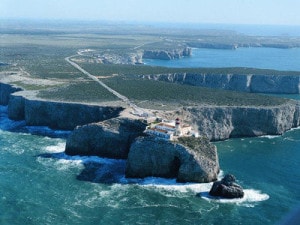 Captain Albert Schoonderbeek
Captain Albert Schoonderbeek
Well the wind did not die off and the frontal system did not diffuse or move away. Instead the flow around Cabot San Vincent only got stronger and whipped up a nice South Westerly swell. What made things worse was that the wind shifted about 2 points more to the South and was thus running in line with the approach course to Portimao. Approaching with the swell in the stern is never pleasant because when you start slowing down the swells tend to overtake the ship and then it feels as if you get a kick in the……. every few minutes when a wave hits the underside of the stern. However it turned out that that was the least of my troubles.
With a wind force 6 blowing we approached the pilot station with an excited pilot on the VHF telling us not to come closer than 2 miles. He was coming out with the pilot boat and he did not have a very comfortable ride as the pilot boat was small and the waves, still building up, were large. I had to put the Prinsendam almost perpendicular on the wind and waves to make a good lee for his boat to come alongside and for him to step on board. By looking at the waves crashing into the breakwater I was already becoming convinced that sailing into port was not going to be a wise thing to do and the pilot quickly confirmed that. The strong wind was blowing straight into the port making it nearly impossible with a high ship as the Prinsendam to stay in the narrow channel. To make matters worse, the swell running into the harbour entrance reduced the depth at entrance by two meters every time a trough was coming through. The minimum depth there was 8 meters, minus 2 meters swell is six and our draft is 7, so we were at least a meter short with every wave trough rolling in. To top things off, there is a river flowing through the port and due to the hard rains yesterday this produced a strong flow through the entrance channel. Our pilot was not a happy chappy when he had to announce that according to him it was not a good idea to go in. (Also the shop keepers normally do not like it when pilots advise cancellations.)
I did not think it was a good idea either and thus we aborted the approach. As the weather was not going to improve until well into the afternoon, it did not have any use to hang around with the ship, so I disembarked the pilot and turned away from the port. After a port cancellation my first thoughts always are; is there something else I can offer the guests. Sometimes there is another port nearby, or you can arrive earlier in the next port if the schedule allows it but in this case it was not easy. Cadiz berth had been booked for tomorrow and a container ship was currently docked there. There is no other port near Portimao that could have taken the Prinsendam. Portimao is the biggest port in the area and even that is a tight squeeze for the Prinsendam.
As we had time on our hands now, we could do some sightseeing however. Why not have a look at the most Western point of Europe, Cabo San Vicente ? That was only 20 miles to the West and easily possible on slow speed while killing time. However this was not as easily done as said. I explained yesterday that there is a now a VTS system around Cabo San Vicente about 10 miles offshore and the area towards the land is prohibited for any ships except those of the locals. However I got permission from ROC Control to steam up to the VTS boundary and to go as close as 3 miles to the main land. Just enough to be able to see the two capes.

Cabo San Vicente. Punta Sagres is the next land tongue to the right.
Cabo San Vicente is the Most Western tip of Europe and Punta Sagres just to the East of it is the most South Western point of Portugal. Both are steep and high with big lighthouses on top, (The one of Cabo San Vicente almost looks like a monastery) and easily visible. Due to the fact that the inshore coast line is now prohibited for deep sea traffic, not a single cruise ship goes there anymore, so at the least the guests had something unique to see and to record in their diaries.
We were there by 10 am. and then made a slow turn to port and sailed in the direction of Cadiz. It was only in the late afternoon that the wind slowly started to abate and the waves were starting to level off. For tomorrow in Cadiz very little wind is expected and it should be a dry day. So things are looking up again.
To access Captain Albert’s historical writings on Holland America Line as well as photos and additional information about Prinsendam and his sailing schedule, click here.

Leave a Reply